From Wikipedia, the free encyclopedia
The Dove Spring Formation (formerly the Ricardo Formation) is a geologic formation in the western Mojave Desert of California.[1] It preserves fossils dating back to the Miocene epoch of the Neogene period.
Fossil content
|
|
|
|
Color key
|
|
Notes
Uncertain or tentative taxa are in small text; crossed out taxa are discredited.
|
Mammals
Bats
Carnivorans
| Carnivorans reported from the Dove Spring Formation
|
| Genus |
Species |
Presence
|
Material |
Notes |
Images
|
| Barbourofelis
|
B. osborni
|
Kern County, California.[1]
|
|
Junior synonym of B. whitfordi.
|
|
| B. whitfordi
|
Red Canyon & other localities, Kern County, California.[2]
|
Teeth & mandible.[2]
|
A barbourofelid.
|
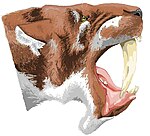
|
| B. sp.
|
LACM localities 6260 & 1108, Kern County, California.[2]
|
Left partial humerus (LACM 140853) & left distal humerus (LACM 59336).[2]
|
A barbourofelid also found in the Green Valley Formation.
|
|
| Bassariscus
|
B. sp.
|
Kern County, California.[1]
|
|
A procyonid.
|
|
| Borophagus
|
B. littoralis
|
Red Rock Canyon, Kern County, California.[3]
|
Left maxillary (LACM 143520).[3]
|
A borophagine dog also found in the Green Valley, Santa Margarita & Chanac formations.
|

|
| Carpocyon
|
C. robustus
|
Kern County, California.[3]
|
Partial skeleton (UCMP 33569).[3]
|
A borophagine dog.
|
|
| cf. Eomellivora
|
cf. E. sp.
|
Kern County, California.[1]
|
|
A large mustelid similar to the honey badger.
|

|
| Epicyon
|
E. aphobus
|
Kern County, California.[1]
|
|
Junior synonym of E. haydeni.
|
|
| E. haydeni
|
Ricardo Fauna, Kern County, California.[3]
|
Skull elements.[3]
|
A borophagine dog.
|

|
| E. saevus
|
Ricardo Fauna, Kern County, California.[1][3]
|
Ramal elements.[3]
|
A borophagine dog.
|

|
| "Felis"
|
"F." sp.
|
Kern County, California.[1]
|
|
A small felid.
|
|
| Ischyrocyon
|
I. gidleyi
|
Last Chance Gulch, Kern County, California.[4]
|
|
A bear-dog.
|
|
| I. mohavensis
|
Kern County, California.[1]
|
|
Junior synonym of I. gidleyi.
|
|
| Leptocyon
|
L. vafer
|
Kern County, California (lower & upper parts of the formation).[1][5]
|
Skull elements.[5]
|
A canine dog.
|

|
| Martinogale
|
M. faulli
|
Red Rock Canyon, Kern County, California.[6]
|
A nearly-complete skull (LACM 56230).[6]
|
A skunk.
|
|
| M. sp.
|
Kern County, California.[1]
|
|
A skunk.
|
|
| "Mephitis"
|
"M." sp.
|
Kern County, California.[1]
|
|
A skunk.
|

|
| Metalopex
|
M. macconnelli
|
Red Rock Canyon, Kern County, California.[5]
|
Skull elements.[5]
|
A fox also found in the Milk Creek Formation & Malheur County, Oregon.
|
|
| Mustela
|
?M. buwaldi
|
Kern County, California.[1]
|
|
A weasel.
|
|
| Osteoborus
|
O. diabloensis
|
Kern County, California.[1]
|
|
Junior synonym of Borophagus littoralis.[3]
|
|
| Pseudaelurus
|
P. sp.
|
Kern County, California.[1]
|
|
A felid.
|
|
| Tomarctus
|
T. robustus
|
Kern County, California.[1]
|
|
Moved to the genus Carpocyon.[3]
|
|
| T. sp.
|
Kern County, California.[1]
|
|
A borophagine dog.
|
|
| "Vulpes"
|
"V." sp.
|
Kern County, California.[1]
|
|
A fox.
|
|
Eulipotyphlans
Lagomorphs
Proboscideans
Rodents
| Rodents reported from the Dove Spring Formation
|
| Genus |
Species |
Presence
|
Material |
Notes |
Images
|
| Acrolophomys
|
A. rhodopetros
|
|
Teeth & dentary.[8]
|
A cricetid.
|
|
| Ammospermophilus
|
A. sp.
|
Kern County, California.[1]
|
|
An antelope squirrel.
|
|
| Antecalomys
|
A. coxae
|
|
Many teeth.[8]
|
A sigmodontine.
|
|
| Bensonomys
|
B. sp.
|
Kern County, California.[8]
|
Maxillae, a dentary & teeth.[8]
|
A sigmodontine.
|
|
| Copemys
|
C. dentalis
|
Kern County, California.[1]
|
Dentaries & teeth.[8]
|
A cricetid.
|
|
| C. cf. C. longidens
|
Kern County, California.[1]
|
|
A cricetid.
|
|
| C. russelli
|
Kern County, California.[1]
|
|
A cricetid.
|
|
| C. sp.
|
Kern County, California.[1]
|
|
A cricetid.
|
|
| C. sp., cf. C. dentalis
|
|
Teeth & jaw elements.[8]
|
A cricetid.
|
|
| Cupidinimus
|
C. avawatzensis
|
Kern County, California.[1]
|
|
A heteromyid also found in the Avawatz Formation.
|
|
| C. tertius
|
Kern County, California.[1]
|
|
A heteromyid.
|
|
| C. sp.
|
Kern County, California.[1]
|
|
A small heteromyid.
|
|
| Eucastor
|
E. sp.
|
Kern County, California.[1]
|
|
A castorid.
|
|
| Leptodontomys
|
L. sp.
|
Kern County, California.[1]
|
|
An eomyid.
|
|
| Lindsaymys
|
L. takeuchii
|
Kern County, California.[8]
|
Multiple specimens.[8]
|
A cotton rat.
|
|
| L. sp., cf. L. takeuchii
|
Kern County, California.[8]
|
Multiple teeth.[8]
|
A cotton rat.
|
|
| L. sp. A
|
Kern County, California.[8]
|
Molars.[8]
|
A cotton rat.
|
|
| L. sp. B
|
Kern County, California.[8]
|
Molars.[8]
|
A cotton rat.
|
|
| Parapliosaccomys
|
P. sp.
|
Kern County, California.[1]
|
|
A gopher.
|
|
| Paronychomys
|
P. spp.
|
Kern County, California.[1]
|
|
A cricetid.
|
|
| Perognathus
|
P. furlongi
|
Kern County, California.[1]
|
|
A pocket-mouse.
|
|
| P. minutus
|
Kern County, California.[1]
|
|
A pocket-mouse.
|
|
| Postcopemys
|
P. sp., cf. P. valensis
|
|
Teeth & dentary.[8]
|
A cricetid.
|
|
| Protospermophilus
|
P. sp.
|
Kern County, California.[1]
|
|
A squirrel.
|
|
| Repomys
|
"R." sp.
|
Kern County, California.[1]
|
|
A cricetid.
|
|
| cf. R. sp.
|
|
M2 (LACM 156378).[8]
|
A cricetid.
|
|
| Tamias
|
T. ateles
|
Kern County, California.[1]
|
|
A chipmunk.
|
|
| "Thomomys"
|
"T." sp.
|
Kern County, California.[1]
|
|
A gopher.
|
|
Ungulates
| Ungulates reported from the Dove Spring Formation
|
| Genus |
Species |
Presence
|
Material |
Notes |
Images
|
| Aphelops
|
A. sp.
|
Kern County, California.[1]
|
|
A rhinoceros.
|
|
| Cormohipparion
|
C. occidentale
|
Kern County, California.[1]
|
Isolated teeth & a lower mandible.[9]
|
Remains reassigned to C. sp.[9]
|
|
| C. sp.
|
El Paso Basin.[9]
|
Isolated teeth & a lower mandible.[9]
|
An equid.
|

|
| Cosoryx
|
C. sp.
|
Kern County, California.[1]
|
|
An antilocaprid.
|
|
| Dinohippus
|
D. cf. D. leardi
|
Kern County, California.[1]
|
|
An equid.
|
|
| ?Hemiauchenia
|
?H. sp.
|
Kern County, California.[1]
|
|
A camelid.
|
|
| Hipparion
|
H. forcei
|
Kern County, California.[1]
|
|
An equid.
|
|
| H. tejonensis
|
Kern County, California.[1]
|
|
An equid.
|
|
| Ilingoceros
|
I. sp.
|
Kern County, California.[1]
|
|
An antilocaprid.
|
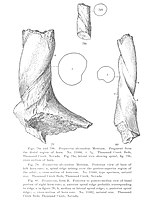
|
| Megahippus
|
M. cf. M. matthewi
|
Kern County, California.[1]
|
|
An equid.
|

|
| ?Megatylopus
|
?M. sp.
|
Kern County, California.[1]
|
|
A camelid.
|

|
| ?Michenia
|
?M. sp.
|
Kern County, California.[1]
|
|
A camelid.
|
|
| Paracosoryx
|
P. furlongi
|
Kern County, California.[1][10]
|
|
An antilocaprid.
|
|
| Peraceras
|
P. sp.
|
Kern County, California.[1]
|
|
A rhinoceros.
|
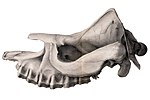
|
| Plioceros
|
P. sp.
|
Kern County, California.[1]
|
|
An antilocaprid.
|
|
| Pliohippus
|
P. tantulus
|
Kern County, California.[1]
|
|
An equid.
|
|
| P. tejonensis
|
Kern County, California.[1]
|
|
An equid.
|
|
| ?Procamelus
|
?P. sp.
|
Kern County, California.[1]
|
|
A camelid.
|
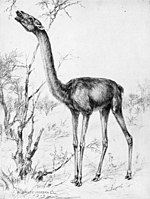
|
| ?Prosthennops
|
?P. sp.
|
Kern County, California.[1]
|
|
A peccary.
|
|
| Teleoceras
|
T. cf. T. meridianum
|
Kern County, California.[1]
|
|
A rhinoceros.
|

|
| Ustatochoerus
|
U. californicus
|
Kern County, California.[1]
|
|
A merycoidodontid.
|
|
| U. cf. U. profectus
|
Kern County, California.[1]
|
|
A merycoidodontid.
|
|
Reptiles
Birds
Squamates
| Squamates reported from the Dove Spring Formation
|
| Genus |
Species |
Presence
|
Material |
Notes |
Images
|
| Anguidae
|
Gen. indet.
|
Kern County, California.[1]
|
|
A very large anguid lizard.
|
|
| Callisaurus
|
C. sp.
|
Kern County, California.[1]
|
|
A zebra-tailed lizard.
|
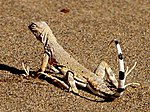
|
| Gerrhonotus
|
G. cf. G. kingi
|
Kern County, California.[1]
|
|
An alligator lizard.
|
|
| Lichanura
|
L. sp.
|
Kern County, California.[1]
|
|
A rosy boa.
|
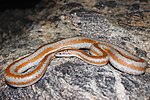
|
| Paleoheterodon
|
P. sp.
|
Kern County, California.[1]
|
|
A colubrid snake.
|
|
| Paracoluber
|
P. sp.
|
Kern County, California.[1]
|
|
A colubrid snake.
|
|
| Paragerrhonotus
|
P. ricardensis
|
Kern County, California.[1]
|
|
An anguid lizard.
|
|
| Proptychophis
|
P. achoris
|
Red Rock Canyon State Park, Kern County, California.[1][11]
|
Numerous vertebrae & the posterior portion of a right maxilla.[11]
|
A colubrid snake.
|
|
| Sceloporus
|
S. sp.
|
Kern County, California.[1]
|
|
A large spiny lizard.
|

|
| "Thamnophis"
|
"T." sp.
|
Kern County, California.[1]
|
|
A garter snake.
|

|
| Uma
|
U. sp.
|
Locality LACM 4702.[12]
|
A partial & fused premaxilla (LACM 159892).[12]
|
A fringe-toed lizard.
|
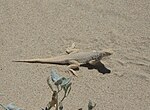
|
| ?Uta
|
?U. sp.
|
Kern County, California.[1]
|
|
A side-blotched lizard.
|

|
| Xantusia
|
X. sp.
|
Kern County, California.[1]
|
|
A night lizard.
|

|
Testudines
Amphibians
Fish
Plants
See also
References
- ^ a b c d e f g h i j k l m n o p q r s t u v w x y z aa ab ac ad ae af ag ah ai aj ak al am an ao ap aq ar as at au av aw ax ay az ba bb bc bd be bf bg bh bi bj bk bl bm bn bo bp bq br bs bt bu bv bw bx by bz ca cb cc cd ce cf cg ch ci cj ck cl cm cn co cp cq cr cs ct cu cv cw Whistler, David P.; Burbank, D. (1992). "Miocene biostratigraphy and biochronology of the Dove Spring Formation, Mojave Desert, California, and characterization of the Clarendonian mammal age (late Miocene) in California". Geological Society of America Bulletin. 104 (6): 644–658. Bibcode:1992GSAB..104..644W. doi:10.1130/0016-7606(1992)104<0644:MBABOT>2.3.CO;2. S2CID 130575409.
- ^ a b c d Tseng, Zhijie J.; Takeuchi, Gary T.; Wang, Xiaoming (2010-01-29). "Discovery of the upper dentition of Barbourofelis whitfordi (Nimravidae, Carnivora) and an evaluation of the genus in California". Journal of Vertebrate Paleontology. 30 (1): 244–254. doi:10.1080/02724630903416001. ISSN 0272-4634. S2CID 21713508.
- ^ a b c d e f g h i j Wang, Xiaoming; Tedford, Richard H.; Taylor, Beryl E. (1999). "Phylogenetic systematics of the Borophaginae (Carnivora, Canidae)". Bulletin of the AMNH (243): 9–391. hdl:2246/1588.
- ^ Hunt, Robert (1998-01-01). "Amphicyonidae". Mammalogy Papers: University of Nebraska State Museum: 196–227.
- ^ a b c d Tedford, Richard H.; Wang, Xiaoming; Taylor, Beryl E. (2009). Phylogenetic systematics of the North American fossil Caninae (Carnivora, Canidae). (Bulletin of the American Museum of Natural History, no. 325). [New York] : American Museum of Natural History. hdl:2246/5999.
- ^ a b Wang, Xiaoming; Whistler, David P.; Takeuchi, Gary T. (2005). "A New Basal Skunk Martinogale (Carnivora, Mephitinae) from Late Miocene Dove Spring Formation, California, and Origin of New World Mephitines". Journal of Vertebrate Paleontology. 25 (4): 936–949. doi:10.1671/0272-4634(2005)025[0936:ANBSMC]2.0.CO;2. ISSN 0272-4634. JSTOR 4524520. S2CID 21747985.
- ^ a b Osborn, Henry Fairfield; Blick, John C.; Frick, Childs (June 1933). "Serbelodon burnhami, a new shovel-tusker from California". American Museum Novitates (639): 1–5. hdl:2246/2061.
- ^ a b c d e f g h i j k l m n o p Thomas S. Kelly; David P. Whistler (2014). "New late Miocene (latest Clarendonian to early Hemphillian) cricetid rodents from the upper part of the Dove Spring Formation, Mojave Desert, California" (PDF). Paludicola. 10 (1): 1–48.
- ^ a b c d Woodburne, Michael O. (2007). "Phyletic diversification of the Cormohipparion occidentale complex (Mammalia, Perissodactyla, Equidae), late Miocene, North America, and the origin of the Old World Hippotherium datum ; Bulletin of the American Museum of Natural History, no. 306". hdl:2246/5872.
- ^ Prothero, Donald R.; Foss, Scott E. (2007-12-17). The Evolution of Artiodactyls. JHU Press. p. 229. ISBN 978-0-8018-8735-2.
- ^ a b Whistler, David P.; Wright, John W. (1989). "A Late Miocene Rear-Fanged Colubrid Snake from California with Comments on the Phylogeny of North American Snakes". Herpetologica. 45 (3): 350–367. ISSN 0018-0831. JSTOR 3892892.
- ^ a b Scarpetta, Simon G. (2019-09-06). "The first known fossil Uma: ecological evolution and the origins of North American fringe-toed lizards". BMC Evolutionary Biology. 19 (1): 178. doi:10.1186/s12862-019-1501-5. ISSN 1471-2148. PMC 6729053. PMID 31492110.
























